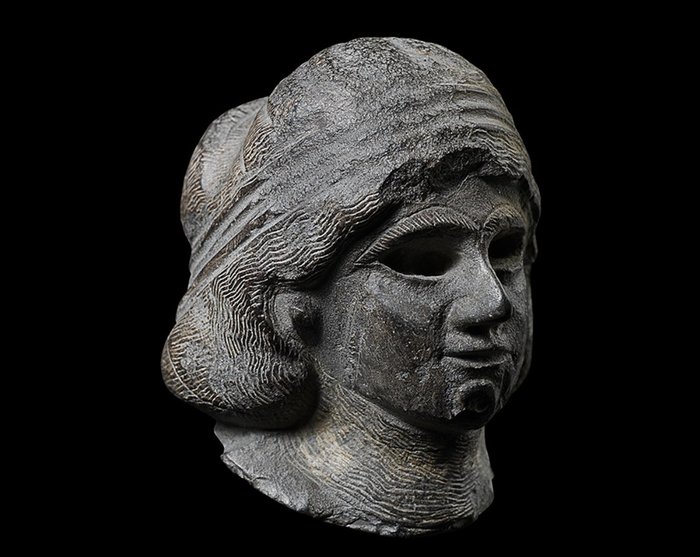
Midden-Oosten, vertel Halaf Terracotta Idool. 3e millennium voor Christus. 6cm hoogte.
Nr. 80966389

Nr. 80966389

Important female head.
Mesopotamia · 3rd millennium BC
Grey stone
Height 8 cm
Provenance:
- Private collection, Professor Hans and Mrs. Maire-Louise Erlenmeyer, Basel (Switzerland), acquired between 1943 and the early 1960s.
Professor Hans Erlenmeyer (March 20, 1900, Strasbourg - May 29, 1967, Basel) was a respected Swiss-German chemist, a member of a lineage of German chemists, and a professor of inorganic chemistry who came to direct the Institute of Inorganic Chemistry in Basel.
Along with his second wife, Marie-Louise Erlenmeyer (née Binder, 1912-1997), he was a passionate collector of antiquities, especially prehistoric and ancient art from Greece and Mesopotamia. Between 1943 and 1967 they amassed a considerable collection, including important groups of Mediterranean and Near Eastern cylinder seals and texts, as well as part of the Keros hoard, which they purchased in the late 1950s and early 1960s. The Erlenmeyer Painter, a painter of Corinthian vases, he was named after a vase in his collection. Part of his collection was loaned to the Basel Museum of Antiquities, as well as to major international exhibitions, and the Erlenmeyer themselves contributed scholarly articles on the field of archeology to scientific publications.
In 1981 Marie-Louise founded the Erlenmeyer Foundation, a charity dedicated to the protection of animal welfare, which managed her collection of antiquities.
The collection was for the most part auctioned off in a series of auctions at Christie's and Sotheby's between 1988 and 1998.
- Cahn International AG, Basel, Switzerland.
- Galerie Harmakhis, acquired from Cahn at the TEFAF fair, on March 17, 2015 for CHF 55,000. (Invoice preserved)
- Art Market, UK, purchased from Galerie Harmakhis.
Condition
Good state of conservation, with erosion on the surface. Assembled from two pieces, the seam is visible as a line running diagonally across the entire head. Small chips, loss in the upper right part of the head.
Sumerian head carved from a gray stone, belonging to a full-length statue that probably represented a woman of the royal family. Her hair, worked through fine parallel incisions, forming soft waves, is shoulder-length, and is collected in a bun on the crown of her head. Her head is adorned with a wide band, with three grooves or folds, possibly representing a textile headdress. Her face is slender, with prominent cheekbones, a straight and thin, triangular nose, and a mouth outlining a smile. Her eyes are large, excavated to accommodate inlays of colored stone or glass, which would add expressiveness to the look. Her eyebrows, large and arched, are highlighted by parallel straight incisions and occupy most of the forehead. Her ears are recessed, with her hair adapting to her shape, which suggests that, originally, the figure could have been adorned with earrings applied to another material. Her chin is decorated with a raised circle, with a central hole, perhaps also originally ornamented with some type of applied material. Finally, her neck appears covered by incised wavy lines, similar to those that represent hair, which wrap around it like a necklace.
These features are characteristic of Mesopotamian statuary from the 3rd millennium BC. It is common to find the narrow forehead, almost hidden by the hairstyle or headdress and by the eyebrows, as well as the delicate smile (fig. 1). Sumerian male sculptures generally feature either a shaved head or a royal turban framing the head. However, women can wear their hair loose around the face, framing the ears adorned with earrings and collected on the nape or crown of the head. A head with a similar arrangement to that of the piece under study can be found in the British Museum (fig. 2).
The combination of different materials in the same sculpture is common in ancient civilizations, from Mesopotamia to Rome, passing through Greece. The contrast of textures and colors brought liveliness to the representations, made them richer and more expressive. It is unusual for more than one of these materials to be preserved (fig. 3), but the way in which pieces such as the head under study appear worked makes it easy to deduce the use of inlays to enrich the representation (fig. 4).
Sumer is the oldest known civilization of Mesopotamia. It arose from the Chalcolithic and the beginning of the Bronze Age, between the 6th and 5th millennia B.C., and its proto-writing dates from before the year 3000 B.C. The first city-states in the area began to appear in prehistoric times, although documents are not preserved until the III Early Dynastic Period, around the 23rd century BC, with the Akkadian Kingdom. The Sumerians developed a material culture of great wealth and importance, both historically and artistically, key to the development of later civilizations in the area. Most of the preserved Sumerian objects are ceramic, although important pieces of precious metal have also been found. Stones such as lapis lazuli, marble, or diorite were highly prized and only obtained through trade routes, so they were reserved for use in sculpture.
Published:
- Christie's. The Standofrd Place Collection of Antiquities. London. April 26, 2006, lot 61.
-Christie's. Antiquities. London. April 14, 2011, lot 309.
-Christie's. Antiquities. London. April 26, 2012, lot 151.
Notes:
The seller guarantees that he acquired this piece according to all national and international laws related to the ownership of cultural property. Provenance statement seen by Catawiki.
The piece includes authenticity certificate.
The piece includes Spanish Export License (Passport for European Union) - If the piece is destined outside the European Union a substitution of the export permit should be requested.
Zo koop je op Catawiki
1. Ontdek iets bijzonders
2. Plaats het hoogste bod
3. Veilig betalen